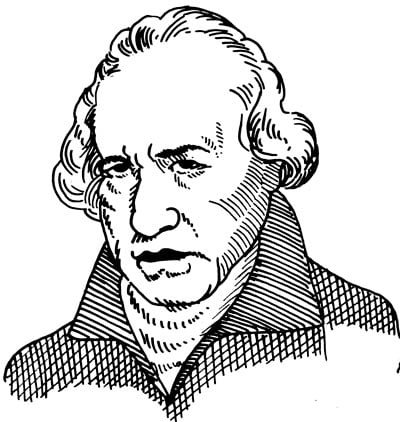
James Watt was born in Greenock in 1736. Watt had little formal education due to poor health in his youth, but pottering about in his father’s shop he developed an interest in trying to make things ‘work like clockwork’.
In his late teens he went to London to learn to be a ‘mathematical and philoso-phical instrument maker’, and when he returned to Glasgow he got a job making instruments with Glasgow University, who gave him accomodation and a workshop.
In 1763 John Anderson asked him to repair an early steam engine he had acquired. This early model, known as a Newcomen engine, was very inefficient. The cylinder had to be heated when steam was admitted, and then gradually cooled again to condense the steam. This wasted a lot of time and fuel. Two years later, while wandering aimlessly through Glasgow Green, Watt hit upon the idea of condensing the steam in a separate vessel. This removed the need for heating and cooling, making the engine faster, safer, and more fuel-efficient. A stone in Glasgow Green marks this spot, where the industrial revolution really began.
Watt went into business with Matthew Boulton, a Birmingham engineer, producing engines based on this new approach. Engineers from all the industrialised countries flocked to see their factories.
Watt’s engines were initially used for pumping water from cornish tin and copper mines. Later, the new cotton mills, which had been built near fast-flowing rivers to take advantage of water power, almost all switched to steam. Gradually, mills began to move toward the centres of population. At first, steam power was used mainly for spinning, but eventually weaving was also powered by steam engine. By 1819, the year of Watt’s death, there were 18 steam weaving factories in Glasgow, with 2800 looms. The increased power-to-weight ratio of the new engines also permitted their use for marine propulsion.
Apart from his steam research, which he originally carried out in the grounds of Kinneil House near Linlithgow, Watt was involved in many other projects. He solved the problem of how to convert the up-and-down piston movement to rotary movement he created the term ‘horsepower’, and he also invented the rev. counter, a machine for copying sculpture, and a letter copying press (a very early photocopier!).
When Watt retired in 1800, he had become a very rich man.
In 1882, 63 years after Watt’s death, the British Association gave his name to the unit of electrical power—and today James Watt’s name is to be found written on almost every lightbulb in the world.

